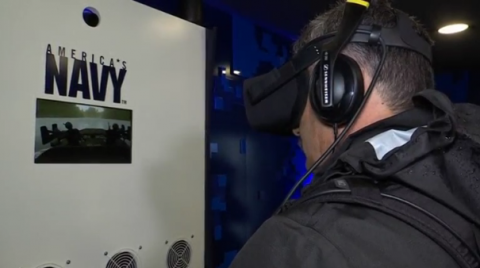
NEW YORK, United States (AFP) — Brace yourself, you are about to experience military combat.
Using virtual reality, civilians can feel like they are part of the action as they pilot a Navy Special Warfare Combatant-Craft as part of a rescue mission.
The mission – to extract a Navy SEAL team pinned down under enemy fire.
The US Navy began using virtual reality simulations last October as a way to engage prospective recruits about careers in the military.
“It’s very exciting, very engaging and it’s a medium that young people today certainly understand and want to be a part of,” said National Director of Navy Marketing and Advertising Captain David Bouve during a stop in New York City on Thursday (May 25).
Participants wear a virtual reality headset to see the action, headphones to hear commands and a soundpack to feel vibrations from the boat’s movements.
“You are the operator of this boat, literally, driving the boat, advancing the throttles, executing your mission up river. So the boat goes literally where you take it.”
“It’s extremely realistic.” Bouve said the team that designed the virtual reality simulation did so after experiencing military drills with the Navy. “So the video that you see is really based on actual footage that they actually shot and the voice comms you hear going back and forth with the crew is based on actual conversations. So it’s about as real as it gets.”
Gillian said she was impressed by the real-life scenario. “It’s riveting. I mean you feel as though you are right in the middle of the danger and the excitement. You are moving very fast, it’s hard to see the details. I’ve never been in quite that situation before.”
In addition to recruiting, Bouve sees other uses for virtual reality in the Navy.
“For example. I’m a pilot. So during the length of time that I’ve been flying, I’ve seen the simulators that we train on evolve very, very markedly with ever-increasing degrees of realism, tactile sensations, more hi-tech, more realistic. So they are not necessarily VR per-se, but clearly we’re moving in that direction. I think to the extent that you can replicate high-risk evolutions cheaply and safely and realistically with the training value, I think there is certainly value in that. So I think we are headed that way as a service.”
Participants do not fire guns as part of the simulation. The Navy said there are plenty of video games where people can pretend to fire weapons. While the US military may use virtual reality to display its technological advancement, military service is not a game.







